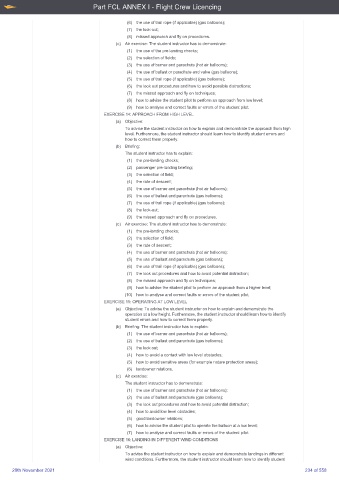Page 234 - UK Aircrew Regulations (Consolidated) 201121
P. 234
Part FCL ANNEX I - Flight Crew Licencing
(6) the use of trail rope (if applicable) (gas balloons);
(7) the look-out;
(8) missed approach and fly on procedures.
(c) Air exercise: The student instructor has to demonstrate:
(1) the use of the pre landing checks;
(2) the selection of fields;
(3) the use of burner and parachute (hot air balloons);
(4) the use of ballast or parachute and valve (gas balloons);
(5) the use of trail rope (if applicable) (gas balloons);
(6) the look out procedures and how to avoid possible distractions;
(7) the missed approach and fly on techniques;
(8) how to advise the student pilot to perform an approach from low level;
(9) how to analyse and correct faults or errors of the student pilot.
EXERCISE 14: APPROACH FROM HIGH LEVEL
(a) Objective:
To advise the student instructor on how to explain and demonstrate the approach from high
level. Furthermore, the student instructor should learn how to identify student errors and
how to correct them properly.
(b) Briefing:
The student instructor has to explain:
(1) the pre-landing checks;
(2) passenger pre-landing briefing;
(3) the selection of field;
(4) the rate of descent;
(5) the use of burner and parachute (hot air balloons);
(6) the use of ballast and parachute (gas balloons);
(7) the use of trail rope (if applicable) (gas balloons);
(8) the look-out;
(9) the missed approach and fly on procedures.
(c) Air exercise: The student instructor has to demonstrate:
(1) the pre-landing checks;
(2) the selection of field;
(3) the rate of descent;
(4) the use of burner and parachute (hot air balloons);
(5) the use of ballast and parachute (gas balloons);
(6) the use of trail rope (if applicable) (gas balloons);
(7) the look out procedures and how to avoid potential distraction;
(8) the missed approach and fly on techniques;
(9) how to advise the student pilot to perform an approach from a higher level;
(10) how to analyse and correct faults or errors of the student pilot.
EXERCISE 15: OPERATING AT LOW LEVEL
(a) Objective: To advise the student instructor on how to explain and demonstrate the
operation at a low height. Furthermore, the student instructor should learn how to identify
student errors and how to correct them properly.
(b) Briefing: The student instructor has to explain:
(1) the use of burner and parachute (hot air balloons);
(2) the use of ballast and parachute (gas balloons);
(3) the look out;
(4) how to avoid a contact with low level obstacles;
(5) how to avoid sensitive areas (for example nature protection areas);
(6) landowner relations.
(c) Air exercise:
The student instructor has to demonstrate:
(1) the use of burner and parachute (hot air balloons);
(2) the use of ballast and parachute (gas balloons);
(3) the look out procedures and how to avoid potential distraction;
(4) how to avoid low level obstacles;
(5) good landowner relations;
(6) how to advise the student pilot to operate the balloon at a low level;
(7) how to analyse and correct faults or errors of the student pilot.
EXERCISE 16: LANDING IN DIFFERENT WIND CONDITIONS
(a) Objective:
To advise the student instructor on how to explain and demonstrate landings in different
wind conditions. Furthermore, the student instructor should learn how to identify student
20th November 2021 234 of 558

